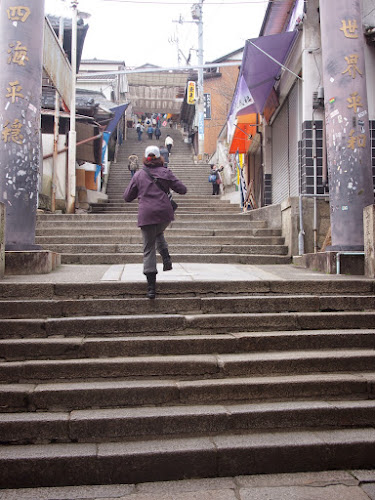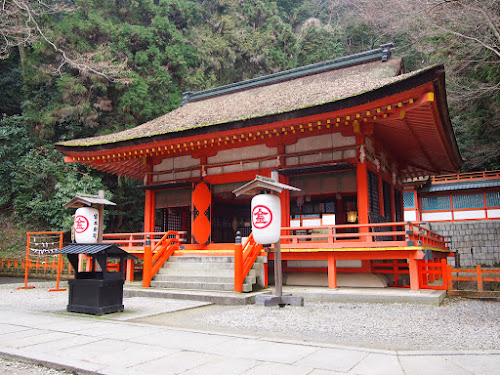Once again we were fogged out of Naoshima, so we took the train out to the town of Kotohira to investigate a popular shrine and an old Kabuki theater.
We followed the flow of pedestrians from the train station towards Kompira san or Kotohira-gu, the most popular Shinto shrine on Shikoku and said to have one of the most “difficult” approaches.
We should have taken the hint when we saw the men with the “kago” or litter for hire to carry people up the mountain.
The beginning of the climb merits some consultation.
Jim naively thought this must be our destination.
After all, other climbers were beginning to show signs of effort.
But, no, on we climbed.
Any chance to stop and take a picture was welcomed by everyone.
For some reason, there seemed to be elderly horses being taken care of at the shrine.
We felt the Asahi-sha was the most interesting building architecturally (if that’s a word).
The shrine is supported by people purchasing various fortunes or amulets.
Kompira san was founded in the 11th century and for centuries served as both Shinto shrine and Buddhist temple. When at the beginning of the Meiji period the government ordered a separation of the two religions, it became a shrine. However, it retains suggestions of both.
Another excuse to breath – this one a mythical creature.
Then upward. A total of 1,368 stone steps.
“Only” 785 steps to the main hall.
Kompira originated as a Hindu deity and found its way to Japan by way of China. Kompira is the protector of sailors, fishermen and all others who make a living from the sea (so there is a minisub here under cover).
We continued upward.
And upward.
Finally, as it began to rain, Kyle continued on his own . . .
. . . finding that at the top one can never reach the summit.
Kanamaruza, Japan’s oldest surviving and operating kabuki theater, was built in 1835. The names of the actors are featured on the white lanterns.
The actors enter the theater on this walkway . . .
. . . or are lifted up through this trapdoor by their colleagues . . .
. . . or through this one, also used for quick changes.
The percussion musicians are shielded from the audience.
Backstage . . .
. . . and under the stage the machinery is all there. Here is the turntable mechanism that can be used to rotate a large section of the main stage.
The contraption above the walkway is used for flying scenes. They’re all ready for the next performance. The man at the ticket booth handed Kyle a flyer on our way out.
On the way back to the station, we stopped off for a sweet potato soft serve ice cream as a reward for a strenuous day.












































